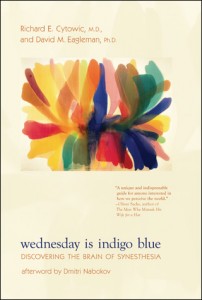THURSDAY, 1 MARCH 2012
In their latest book, Wednesday is Indigo Blue, Drs. Richard Cytowic and David Eagleman summarize what the scientific community has learned about synaesthesia thus far. From the tell-tale signs used to clinically diagnose the condition, to illustrated depictions of various synaesthetic experiences and possible explanations for why synaesthetes experience these different types of sensory mismatch.As Cytowic and Eagleman explain, the rise of a psychological school of thought known as behaviourism initially discouraged studies of the human mind in the early twentieth century. Without the brain imaging technology available now, studies relied on self-reporting, which was potentially biased. Only with the recrudescence of neurobiology and neuroimaging in the 1990s, “the Decade of the Brain”, did research in synaesthesia finally take off.
Both Cytowic and Eagleman were the pioneers of synaesthesia research as early as in the 1980s, but even their credibility can’t hide how little is understood about synaesthesia. The data presented in their book are highly variable as scientific data are generally wont to be, making for 300 pages of ultimately inconclusive text.
Wednesday is Indigo Blue raises more questions than it answers. Does synaesthesia arise from increased wiring between different parts of the brain or from a failure to inhibit this crosstalk? Synaesthesia, the authors suggest, may lie somewhere on a continuum of ordinary perception. Do non-synaesthetes just express a less extreme condition, as evinced by everyday use of metaphoric language?
This frustrating ambiguity is precisely the authors’ point. Cytowic and Eagleman seem to insist that synaesthesia is very much a real condition that merits further research, not some phony pseudoscience. Though at times it reads like an indirect petition for more grant money, Wednesday Is Indigo Blue thoroughly characterizes a condition suffered by the brilliant likes of Vladimir Nabokov, Wassily Kandinsky and Stevie Wonder, making it the definitive layman’s text for synaesthesia.
Written by Leila Haghighat

